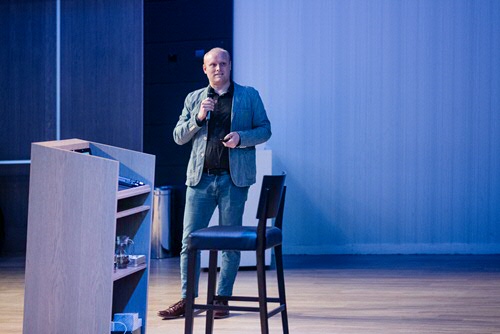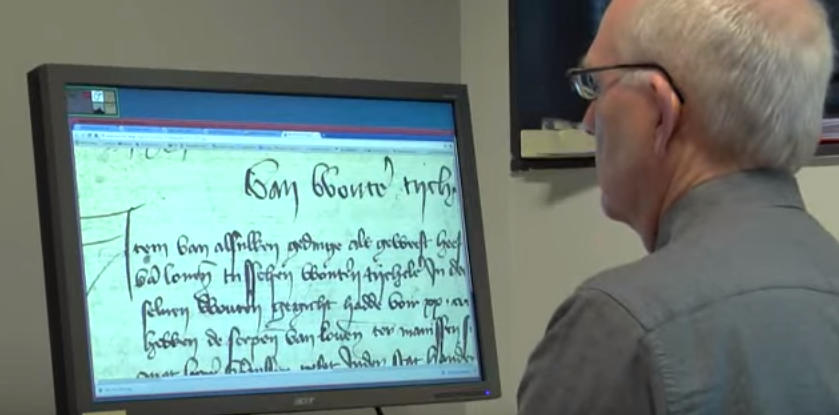Artificial intelligence selects best candidate

Looking for needles in gigantic virtual haystacks? Or drawing-pins? Staples? The staff at Target Holding are never flummoxed by the huge volumes of digital data their clients supply them with. Artificial intelligence is often the key to spectacular results, helping companies to deploy both their human and their financial resources more efficiently.
Text: Gert Gritter / Communication Office UG
As well as being Senior Machine Learning Engineer at Target Holding (a UG spin-off), Jean-Paul van Oosten is also a PhD student. Both his PhD research and his work revolve around highly diverse ‘mountains of data’, in which smart systems recognize patterns and make connections. He does this using Machine Learning (ML). ML is the term used for the self-learning capacity of intelligent computers, which allows data to be enriched. One of the applications discovered by Van Oosten and his colleagues is a method for selecting the best candidates for a job from hundreds of curricula vitae and letters of application. The task of going through the electronic post to find suitable candidates takes HR staff many hours, but AI systems can do it in just seconds. The systems are programmed to identify relevant combinations of data, ignore unimportant information and weigh up the data.
Pattern recognition
Target Holding develops a wide range of applications, including applications for infrastructure, media, Human Resources and Life & Health. One of Van Oosten’s colleagues was awarded a PhD in 2014 for research into pattern recognition used to assess whether someone has skin cancer or a harmless mole. This skin classification system works well, and in some cases even better than a specialist deciding whether a skin blemish is dangerous or not. Another example comes from the world of forensics. Certain programmes can compare the handwriting of the author of a threatening letter with that of a suspect. A programme makes a statistical comparison and produces a list of comparable pieces of handwriting, sorted in ascending order of similarity. This can then be used to identify a suspect.
Hand-written texts
As part of his thesis, Van Oosten is studying historical hand-written texts from the AI angle. They include texts from the Dutch National Archives relating to the King’s Office. He is using the Monk system, developed at the UG’s ALICE (Artificial Intelligence Institute) under the supervision of Prof. Lambert Schomaker. Monk uses pattern recognition and machine learning algorithms for hand-written texts in various archives, including historical collections from the Middle Ages, Chinese manuscripts and the Dead Sea Scrolls. ‘Automatic searches in vast collections of documents or categorizing texts from webpages, articles, emails and books is becoming increasingly important,’ says Van Oosten. ‘Pages are dissected into sentences, words and letters. Having done this, we can analyse the content and see what has been written. We can tell in which era it was written, for example, and who wrote it. Or where it was written, in the southern or northern Netherlands. But apart from hand-written text recognition, an algorithm can also make calculations based on words. Traditional software usually works on direct key words, but this can give problems. Here’s a simple example. The word ‘bank’ can be used to describe a piece of land sloping down to a river or a place where money is stored. Target deploys a different strategy by analysing the context. It is fairly safe to assume that words used in the same context are linked. If the words ‘bank’ and ‘river’ often appear in the same context, the internal mathematical representation of these words will automatically be similar. The algorithm then performs a word calculation and makes a link between words, without an explicit command having been given.’

Target Holding
The Groningen-based company Target Holding evolved in 2009 from a collaboration project with UMCG, Astron, IBM, the University of Groningen and Oracle. It was originally intended as a means of bringing innovative knowledge generated through optical astrophysics, radio astrophysics and genetic data onto the market for the first time and hailed as the Netherlands’ biggest public-private IT project ever. Van Oosten is now working on several projects at Target Holding, but hopes to complete his PhD in 2018. He finds the working environment and atmosphere highly inspiring. ‘The company is thriving. We recently took on another 15 people, many of them Master’s or PhD students from the UG. We have an open-plan office with conference rooms providing an entire wall of white board for brainstorming and scrumming. We’re commissioned by our customers to optimize production processes, so we often do things that no-one’s ever done before. It gives us a real buzz every time we sort out a problem facing one of our customers.’
More information
- Jean-Paul van Oosten
- Video: Van Oosten on how to find the best candidate
- Video: Who wrote the Dea Sea Scrolls?
| Last modified: | 12 March 2020 9.23 p.m. |
More news
-
03 April 2025
IMChip and MimeCure in top 10 of the national Academic Startup Competition
Prof. Tamalika Banerjee’s startup IMChip and Prof. Erik Frijlink and Dr. Luke van der Koog’s startup MimeCure have made it into the top 10 of the national Academic Startup Competition.
-
01 April 2025
NSC’s electoral reform plan may have unwanted consequences
The new voting system, proposed by minister Uitermark, could jeopardize the fundamental principle of proportional representation, says Davide Grossi, Professor of Collective Decision Making and Computation at the University of Groningen
-
01 April 2025
'Diversity leads to better science'
In addition to her biological research on ageing, Hannah Dugdale also studies disparities relating to diversity in science. Thanks to the latter, she is one of the two 2024 laureates of the Athena Award, an NWO prize for successful and inspiring...
